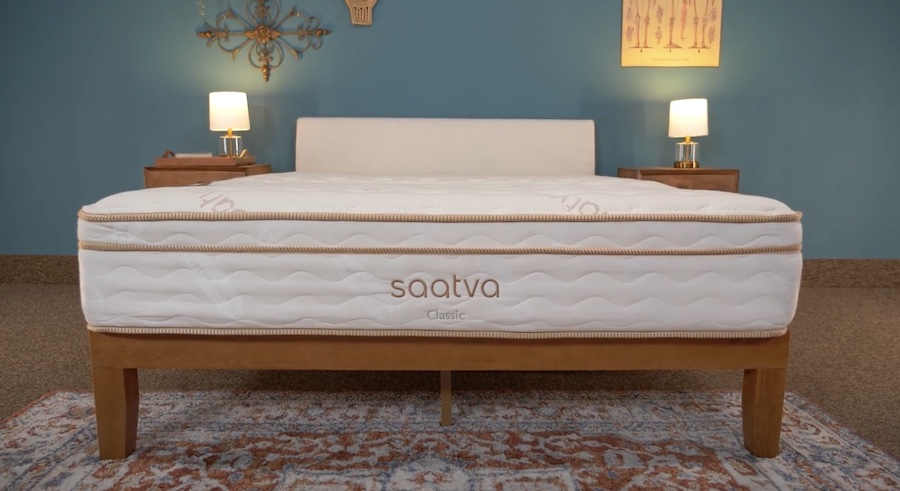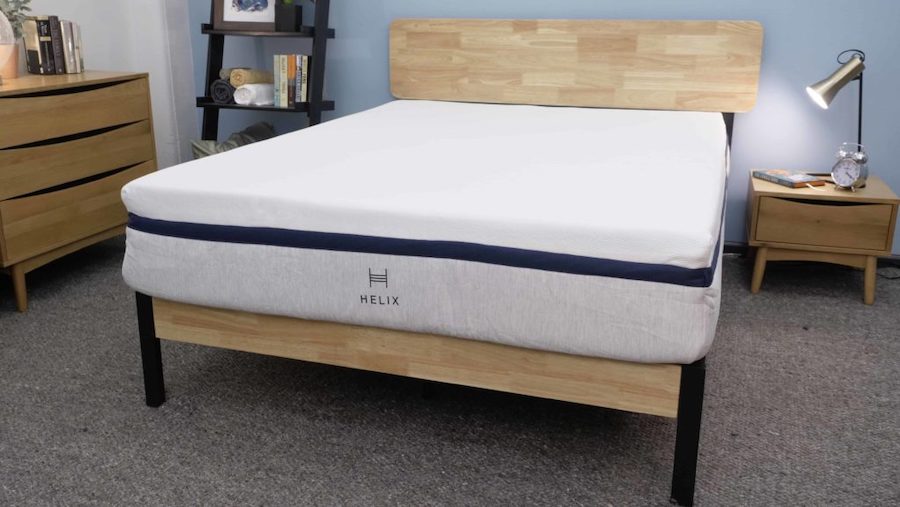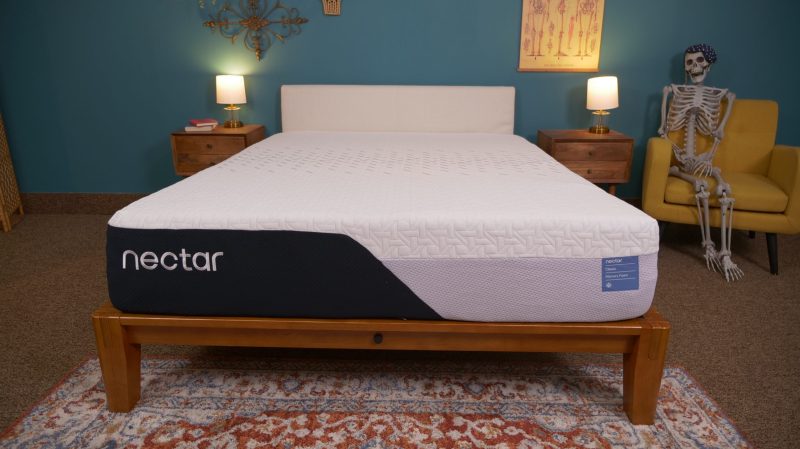For anyone navigating back pain, the right bed can make all the difference. Back pain affects every part of your life, from trying to get through your day to the way you sleep at night.
Switching to an adjustable bed may be the solution you need. Below, we’ll break down exactly how an adjustable bed could leave you feeling more comfortable for a better night’s sleep. We’ll also look at the most important things to know before you buy.
Dr. Raj Explains the Benefits of an Adjustable Bed

How an Adjustable Bed Alleviates Back Pain
Supports Your Back
Sleeping on a slight incline with an adjustable bed can help support your back so your spine remains neutral. Plus, adjustable bases are ideal for back sleeping, which is considered the optimal posture for a neutral spine.1
While many people try to raise their head and shoulders, or their knees, with pillows, an adjustable base offers a more seamless option since pillows could easily fall out of position if you move around.
You can also find mattresses to alleviate back pain in our best mattress for back pain guide.
Reduces Pressure on the Lower Back
Sometimes flat mattresses can worsen back problems by putting pressure on your spine, particularly the lower back. Sleeping on a slight incline could help relieve tension in the lower back, and for extra relief, try raising your knees.2 When you elevate both your upper back and knees slightly, this changes where your body experiences pressure, taking the weight off your spine and distributing it more evenly to help reduce pain.
Aids Mobility
If you have mobility issues that make it difficult to get in and out of bed, an adjustable bed could help. Adjustable beds can be raised and lowered to a height that allows you to get both feet securely planted on the ground, making standing up easier and safer. Also, you can raise the back of the bed so that you don’t have to start from a prone position, which can help you use less energy when it comes time to get out of bed.
Although adjustable beds may not directly help prevent or reverse mobility loss, they may reduce pain and be a helpful tool to help people remain more independent.
Back Conditions That May Benefit From an Adjustable Bed
Sleepers who experience specific back problems may find that an adjustable bed works better to alleviate the symptoms of these conditions than a flat mattress can.
Osteoarthritis
Osteoarthritis is a common type of arthritis that comes with aging and the general wear and tear of joints.3 Sleeping on an adjustable bed won’t reverse the effects of osteoarthritis, but it may help manage the accompanying pain.
Sleep may intensify osteoarthritis pain due to pressure buildup around the joints. Adjustable beds can be modified so your weight’s more evenly distributed, taking pressure off your joints.
If you have arthritis, consider an adjustable base with a memory foam mattress or latex mattress that rates well for pressure relief.
Interested in exploring further? See our complete guide to the best mattress for arthritis here.
Spinal Stenosis
If you experience back pain while walking that goes away when you sit down, you may be experiencing the side effects of spinal stenosis. Spinal stenosis is the result of the narrowing of the spaces in the spine.4
With an adjustable mattress, people with spinal stenosis can find support in an upright position that reduces the pressure on the vertebrae that cause this discomfort. People with spinal stenosis may reap the most benefits from an adjustable bed paired with a supportive memory foam or latex mattress.
See Our Full Guide: Best Mattress for Spinal Stenosis
Degenerative Spondylolisthesis
Degenerative spondylolisthesis is when a vertebra slips out of place and rests against the vertebra below it.5 The compression or pinching of the nerve roots coming out of the spinal canal can cause pain in your lower back and legs.
An adjustable bed, especially one that can also elevate the legs, can help take pressure off these areas. Plus, an adjustable base is a better option than using pillows or blankets since it will remain in place throughout the night, even if you need to reposition.
Sciatica
Sciatic pain is the result of pressure or damage to the sciatic nerve.6 People with sciatica often experience radiating pain that moves through this path, causing discomfort, especially in the legs.
Sciatic pain usually resides in the buttocks and legs, so sleepers with sciatica may benefit more if they raise their knees with an adjustable mattress. Lifting the legs may help relieve pressure on the lumbar discs and reduce pain generated by the sciatic nerve.
A mattress with excellent pressure relief and weight support may help those who experience sciatica.
Check Out Our Guide: Best Mattress for Sciatica
Herniated Disc
A herniated disc is a slipped disc that can create pain and pressure in nearby areas of the spine.7 The majority of the time, the herniation is in the lower back, but some people may experience it in other areas due to how active they are or the types of exercises they enjoy.
Lower back pain, including the type caused by a herniated disc, is often alleviated by keeping your spine aligned and your body weight evenly distributed. An adjustable mattress allows you to modify your upper and lower body so that your weight is evenly distributed and the natural curve of your spine is maintained.
Check Out Our Guide: Best Mattresses for Herniated Discs
Things to Consider Before Purchasing an Adjustable Bed to Relieve Back Pain
Before you purchase an adjustable bed to treat your back pain, consider a few things to ensure that you find the right combination of mattress and adjustable frame for your needs.
- Mattress Type – Memory foam and latex mattresses work best because of their flexible structure. They can withstand the regular bending of an adjustable frame. Hybrid mattresses may also work. Each type of mattress will offer varying levels of pressure relief and support. We don’t recommend using an innerspring mattress with an adjustable frame as the coil structure doesn’t offer much flexibility, and the bending will reduce the mattress’s lifespan.
See Our Full Guide: Best Mattress for Adjustable Beds
- Bed Size – You can use an adjustable frame with any bed size, and adjustable bed frames are generally the same size as the traditional frame for each mattress size. However, because of the head and foot machinery, you may want to account for some extra space in your room so that these pieces can move freely and won’t be impacted by any other furniture in the room.
- Weight – Adjustable bed frames are typically heavier than traditional beds because of the additional machinery. They can also have specific weight limits. Make sure that when you choose your frame, it’s appropriate for the room you’d like to use it in and that it can support your weight. The other weight-related issue to consider is making sure that you choose a mattress that will best support your weight, especially in a back-sleeping position.
A Few of Our Favorite Mattresses for Adjustable Beds
Product
Type
Score
What Is the Best Adjustable Bed Position for Back Pain?
If you have a medical condition, your doctor may recommend an ideal sleeping position for you.
Most people with spinal conditions find that back sleeping works well when they adjust their beds to contour to their spine’s natural ‘S’ shape.1
However, sleeping with the torso and legs slightly elevated — also known as the “zero-gravity posture” — can help take even more pressure off the lower back.2
Side sleepers can also slightly raise both the head and foot sections to simulate the fetal position, reducing tension and supporting the spine.
Get More Info: Zero Gravity Sleep Position Benefits
Frequently Asked Questions
Can adjustable beds cause lower back pain?
If you don’t use an adjustable bed correctly, it could cause lower back pain. For example, stomach sleepers shouldn’t use adjustable frames because they could cause the lower back to hyperextend, which can worsen pain.
Is it good for your back to sleep on an adjustable bed?
Sleeping on an adjustable bed can be good for your bed because a slight upper body incline and elevated knees promote the spine’s natural ‘S’ curve.
Do doctors recommend adjustable beds?
Doctors may recommend adjustable beds to people with certain health conditions, but this depends on each patient and their individual circumstances. If you’re considering one and your doctor hasn’t brought it up, we recommend consulting them first, especially if you have a pre-existing back condition.
What are the disadvantages of an adjustable bed?
Most disadvantages of an adjustable bed are related to its size and weight. These beds are typically much heavier and bulkier than regular models. On top of that, they may be noisier due to their moving parts. These beds are also typically much more expensive than regular frames.
Final Word of Advice
If you regularly experience back pain that gets worse by sleeping on a flat surface, consider investing in an adjustable bed and a foam or latex mattress. In some cases, doctors may recommend adjustable bed frames to those who experience specific medical conditions associated with back pain, as well as other medical conditions such as sinus or respiratory issues or acid reflux. Talk to your doctor about how you might benefit from an adjustable bed.
An adjustable bed and compatible mattress may be an investment, but they could be a lifesaver if you have trouble sleeping because of back pain.

Jill Zwarensteyn
Senior Editor
About Author
Jill Zwarensteyn is the senior editor for Sleep Advisor and a certified sleep science coach. She is enthusiastic about providing helpful and engaging information on all things sleep and wellness.
Combination Sleeper
Education & Credentials
- Certified Sleep Science Coach
References:
- Yu MD, Elizabeth. “What sleep positions are best for your back?”. Ohio State University Wexner Medical Center. 2018.
- “The Best Sleeping Positions for Lower Back Pain”. Reid Health. Webpage accessed May 20, 2024.
- “Osteoarthritis”. National Institute of Arthritis and Musculoskeletal and Skin Diseases. Last modified September 2023.
- “Spinal Stenosis”. National Institute of Arthritis and Musculoskeletal and Skin Diseases. Last modified November 2023.
- Kalichman, Leonid., Hunter, David J. “Diagnosis and conservative management of degenerative lumbar spondylolisthesis”. European Spine Journal. 2008.
- “Sciatica”. Penn Medicine. Last modified September 20, 2022.
- “Herniated Disc Disorders”. Penn Medicine. Webpage accessed May 20, 2024.


